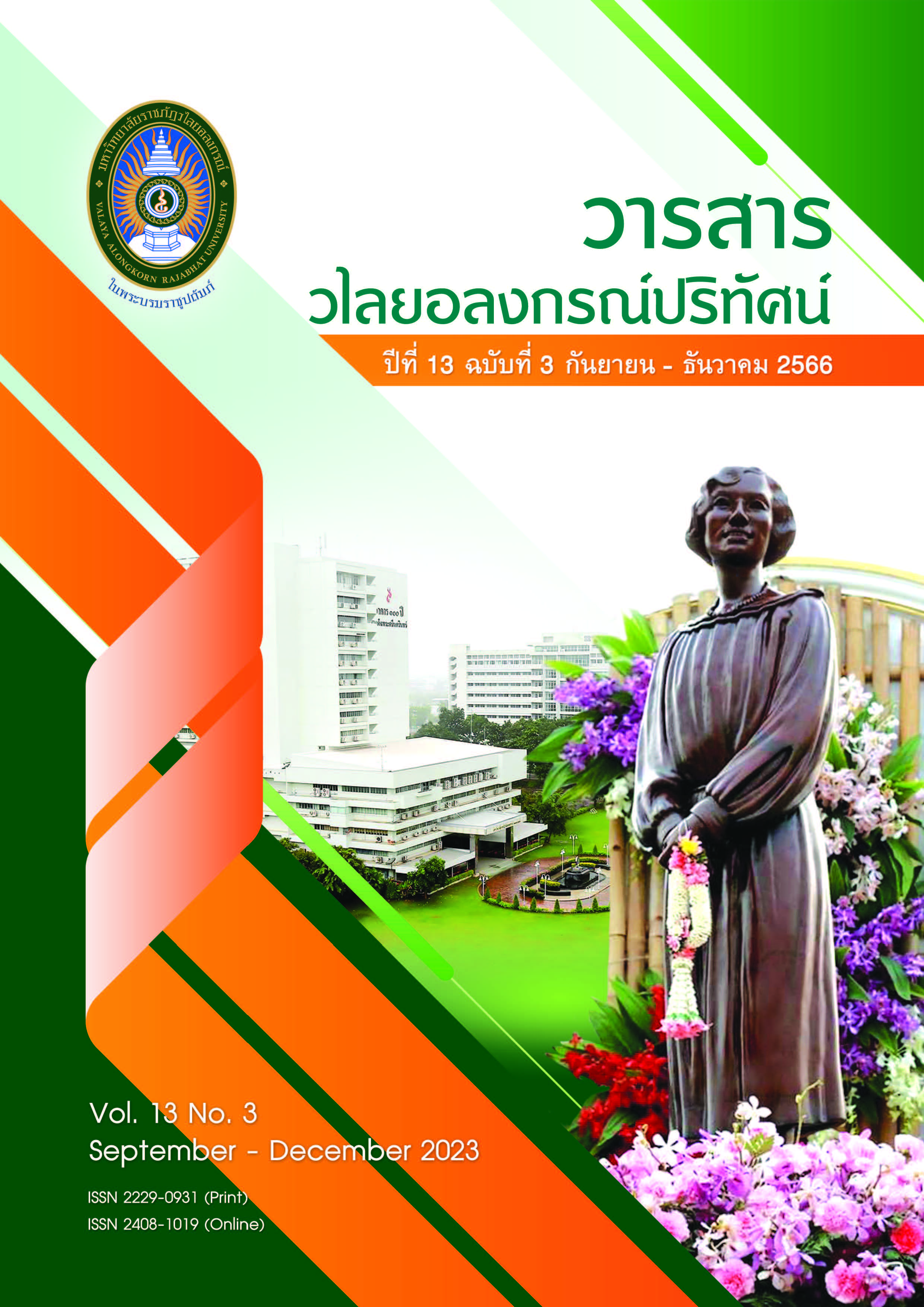การศึกษาองค์ประกอบรูปแบบการสอนการอ่านภาษาอังกฤษ ด้วยวิธีการเรียนรู้อย่างมีความหมายและการสร้างความรู้ด้วยตนเอง สำหรับนักเรียนชั้นมัธยมศึกษาปีที่ 1
คำสำคัญ:
องค์ประกอบรูปแบบการสอน, รูปแบบการสอน, การสอนอ่านภาษาอังกฤษบทคัดย่อ
การวิจัยครั้งนี้มีวัตถุประสงค์เพื่อ 1) ศึกษาองค์ประกอบของโครงร่างรูปแบบการสอน การอ่านภาษาอังกฤษด้วยวิธีการเรียนรู้อย่างมีความหมายและการสร้างความรู้ด้วยตนเอง สำหรับนักเรียนชั้นมัธยมศึกษาปีที่ 1 และ 2) ศึกษาความเหมาะสมขององค์ประกอบของโครงร่างรูปแบบ การสอนการอ่านภาษาอังกฤษด้วยวิธีการเรียนรู้อย่างมีความหมายและการสร้างความรู้ด้วยตนเอง สำหรับนักเรียนชั้นมัธยมศึกษาปีที่ 1 ผู้ให้ข้อมูล ได้แก่ ผู้เชี่ยวชาญด้านการสอนภาษาอังกฤษ จำนวน 5 คน ได้มาด้วยวิธีการสุ่มแบบแบ่งกลุ่ม เครื่องมือที่ใช้ในการวิจัย คือ แบบประเมินความเหมาะสมสอดคล้องของโครงร่างรูปแบบการสอนการอ่านภาษาอังกฤษด้วยวิธีการเรียนรู้อย่างมีความหมายและการสร้างความรู้ด้วยตนเอง สำหรับนักเรียนชั้นมัธยมศึกษาปีที่ 1 ค่าความสอดคล้อง เท่ากับ 4.93 การเก็บรวบรวมข้อมูลด้วยการสอบถามความคิดเห็นจากผู้เชี่ยวชาญด้านการสอนวิชาภาษาอังกฤษ สถิติที่ใช้ในการวิเคราะห์ข้อมูล ได้แก่ ค่าเฉลี่ย และส่วนเบี่ยงเบนมาตรฐาน
ผลการวิจัยพบว่า
1. โครงร่างรูปแบบการสอนการอ่านภาษาอังกฤษด้วยวิธีการเรียนรู้อย่างมีความหมายและการสร้างความรู้ด้วยตนเอง สำหรับนักเรียนชั้นมัธยมศึกษาปีที่ 1 ประกอบด้วย 6 องค์ประกอบ ดังนี้ 1.1) หลักการ 1.2) วัตถุประสงค์ 1.3) เนื้อหา 1.4) กระบวนการจัดกิจกรรมการเรียนการสอน 1.5) สื่อและแหล่งเรียนรู้ และ 1.6) การวัดผลและการประเมินผล
2. ผลการศึกษาความเหมาะสม สอดคล้องขององค์ประกอบของโครงร่างรูปแบบการสอนการอ่านภาษาอังกฤษด้วยวิธีการเรียนรู้อย่างมีความหมายและการสร้างความรู้ด้วยตนเอง สำหรับนักเรียนชั้นมัธยมศึกษาปีที่ 1 พบว่า ภาพรวมขององค์ประกอบของโครงร่างรูปแบบการสอนทั้งหมดอยู่ในระดับมาก (M = 4.12, S.D. = 0.59) ซึ่งแบ่งเป็น 2.1) หลักการ (M = 4.00, S.D. = 0.44) 2.2) วัตถุประสงค์ (M = 4.20, S.D. = 0.67) 2.3) เนื้อหา (M = 4.00, S.D. = 0.44) 2.4) กระบวนการจัดกิจกรรมการเรียนรู้ (M = 4.80, S.D. = 0.56) 2.5) สื่อและแหล่งการเรียนรู้ (M = 3.80, S.D. = 0.54) และ 2.6) การวัดผลและการประเมินผล (M = 3.80, S.D. = 0.67)
เอกสารอ้างอิง
กระทรวงศึกษาธิการ. (2551). หลักสูตรแกนกลางการศึกษาขั้นพื้นฐาน พุทธศักราช 2551 กลุ่มสาระการเรียนรู้ภาษาต่างประเทศ. กรุงเทพฯ: ชุมนุมสหกรณ์การเกษตรแห่งประเทศไทย.
จริยา มีโชค. (2558). การพัฒนาความสามารถในการอ่านภาษาอังกฤษเพื่อความเข้าใจของนักเรียนชั้นมัธยมศึกษาปีที่ 1 โรงเรียนนาเชือกพิทยาสรรค์โดยวิธีการอ่านแบบ skimming และ scanning. วิทยานิพนธ์ครุศาสตรมหาบัณฑิต สาขาวิชาการสอนภาษาอังกฤษในฐานะภาษาต่างประเทศ มหาวิทยาลัยราชภัฏบ้านสมเด็จเจ้าพระยา.
ทิศนา แขมมณี. (2560). ศาสตร์การสอน. (พิมพ์ครั้งที่ 6). กรุงเทพฯ: จุฬาลงกรณ์มหาวิทยาลัย.
บุญชม ศรีสะอาด. (2558). การวิจัยเบื้องต้น. (พิมพ์ครั้งที่ 5). กรุงเทพฯ: สุวีริยศาสน์.
ประภาเพ็ญ สุวรรณ. (2559). การวัดผลและการเปลี่ยนแปลงพฤติกรรม. กรุงเทพฯ: ไทยวัฒนาพานิช.
เพลินพิศ สุปัญญาบุตร. (2560). การพัฒนาผลสัมฤทธิ์ด้านการอ่านเพื่อความเข้าใจภาษาอังกฤษโดยใช้เทคนิคการอ่านแบบ skimming และ scanning. วิทยานิพนธ์ศึกษาศาสตรมหาบัณฑิต สาขาวิชาหลักสูตรและการสอน มหาวิทยาลัยขอนแก่น.
ล้วน สายยศและอังคณา สายยศ. (2560). เทคนิคการวิจัยทางการศึกษา. กรุงเทพฯ: สุวีริยาสาส์น.
วราภรณ์ พรมอินทร์. (2561). การพัฒนาความสามารถในการอ่านภาษาอังกฤษเพื่อความเข้าใจของนักเรียนชั้นมัธยมศึกษาปีที่ 5 โดยกลวิธีการอ่านแบบร่วมมือ. วิทยานิพนธ์การศึกษามหาบัณฑิต สาขาวิชาหลักสูตรและการสอน มหาวิทยาลัยบูรพา.
วัฒนาพร ระงับทุกข์. (2560). การจัดการเรียนการสอนที่เน้นผู้เรียนเป็นสำคัญ. (พิมพ์ครั้งที่ 4). กรุงเทพฯ: ต้นอ้อ.
สงัด อุทรานันท์. (2560). พื้นฐานและหลักการพัฒนาหลักสูตร. (พิมพ์ครั้งที่ 5). กรุงเทพฯ: มิตรสยาม.
สุภัทรา อักษรานุเคราะห์. (2560). ภาษาอังกฤษในห้องเรียนสำหรับครู. กรุงเทพฯ: จุฬาลงกรณ์มหาวิทยาลัย.
อาภรณ์ ใจเที่ยง. (2557). หลักการสอน. (พิมพ์ครั้งที่ 5). กรุงเทพฯ: โอ. เอส. พริ้นติ้งเฮ้าส์.
Abdul, H. S. (2019). The use of skimming & scanning techniques in reading comprehension for TOEFL. Master’s Thesis. Darussalam – Banda Aceh.
Anderson, J. R. (1997). The architecture of cognition. New York: Harvard University.
Arends, R. I. (1999). Classroom instruction & management. New York: McGraw Hill.
Ausubel, D. P. (1970). The psychology of meaningful verbal learning theory: New York: Grune & Stratton.
Ausubel, D. P. (1998). Theory and problems of child development. New York: Grune & Stratton.
Gunter, Esters, & Schwab, J. (1995). Instruction model approach. Boston: Allyn & Bacon.
Grellet, F. (2000). Developing reading skills. Cambridge, United Kingdom: Cambridge University.
Joyce, B., & Calhoun, E. (2004). Model of teaching. Boston: Allyn & Bacon.
Joyce, B., & Weil, M. (2000). Model of teaching. Boston: Allyn & Bacon.
Joyce, B., & Weil, M. (1996). Model of teaching. (4th ed.). Boston: Allyn & Bacon.
Kemp, J. E. (2000). The instructional design process. New York: Harper & Row.
Klingner, J. K., Vaughn, S. (1998). Collaborative strategic reading (CSR): Involving all students in content area learning. Teaching exceptional children, (30, pp. 32-37).
Vygotsky, L. S. (1987). The historical meaning of the crisis in psychology: A methodological investigation. The collected works of Vygotsky. New York: Plenum.
ดาวน์โหลด
เผยแพร่แล้ว
รูปแบบการอ้างอิง
ฉบับ
ประเภทบทความ
สัญญาอนุญาต
ลิขสิทธิ์ (c) 2023 ฐณมน สมชนะ, กันต์ฤทัย คลังพหล, พิทักษ์ นิลนพคุณ, สมบัติ คชสิทธิ์

อนุญาตภายใต้เงื่อนไข Creative Commons Attribution-NonCommercial-NoDerivatives 4.0 International License.
ข้อความที่ปรากฏในบทความแต่ละเรื่องในวารสารวไลยอลงกรณ์ปริทัศน์ เป็นความคิดเห็นของผู้นิพนธ์แต่ละท่าน มิใช่เป็นทัศนะและมิใช่ความรับผิดชอบของกองบรรณาธิการจัดทำวารสาร และ
มหาวิทยาลัยราชภัฏวไลยอลงกรณ์ ในพระบรมราชูปถัมภ์


